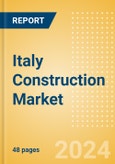The analyst expects the Italian construction industry to contract in real terms by 6.7% in 2025 and 7% in 2026, owing to falling building permits and rising public debt, coupled with weak industrial construction sectors. This decline is majorly attributed to the weak residential market owing to the phasing out of the Superbonus tax credit scheme. The government is phasing out the Superbonus tax credit scheme but has permitted only homeowners to claim up to a 65% deduction for ongoing residential work that began before October 15, 2024; down from 110% tax claim previously allowed under the scheme. According to the Italian National Institute of Statistics (Istat), the gross fixed capital formation in dwellings declined by 7.2% year on year (YoY) in Q4 2024, preceded by a Y-o-Y decline of 5.4% in Q3 and 0.8% in Q2 2024. Weakness in the industrial construction sector is also expected to weigh on the Italian construction industry. In November 2024, the Italian government revealed that it will cut around EUR4.6 billion ($5 billion) in the automotive budget out of the total EUR5.8 billion ($6.3 billion) assigned for automotive sector from 2025 to 2030. These funds will be diverted to fund the defense sector, which will further weaken the industrial construction sector in the country.
Over the remainder of the forecast period, the Italian construction industry is however expected to recover in 2027 and record an average annual growth of 1.5% between 2027 and 2029, supported by investments in renewable energy, transport infrastructure, and hospitality sectors, coupled with the government's aim to increase the share of renewable energy in the total power mix from 18.5% in 2022 to 59% in 2030. In line with this, in March 2025, government-owned national transmission grid operator Terna revealed its plans to invest EUR23.5 billion ($25 billion), from 2025 to 2034 to boost the energy capacity in the country. Previously, in December 2024, the European Commission (EC), approved EUR9.7 billion ($10.3 billion) to support the construction of new solar PV, onshore wind, and hydropower with a combined capacity of 17.7GW. Growth over the forecasted period will also be supported by the government-owned railway company Rete Ferroviaria Italiana (FS Group) plan announced in December 2024 to invest EUR100 billion ($106.4 billion) to develop the overall railway infrastructure in the country from 2025 to 2029. Also, as of March 2025, the construction work of the Brenner Tunnel project is underway which includes the construction of a 54.7km tunnel between Fortezza in Italy, and Innsbruck in Austria, estimated at EUR8 billion ($8.5 billion) and is expected to be completed by 2032.
Over the remainder of the forecast period, the Italian construction industry is however expected to recover in 2027 and record an average annual growth of 1.5% between 2027 and 2029, supported by investments in renewable energy, transport infrastructure, and hospitality sectors, coupled with the government's aim to increase the share of renewable energy in the total power mix from 18.5% in 2022 to 59% in 2030. In line with this, in March 2025, government-owned national transmission grid operator Terna revealed its plans to invest EUR23.5 billion ($25 billion), from 2025 to 2034 to boost the energy capacity in the country. Previously, in December 2024, the European Commission (EC), approved EUR9.7 billion ($10.3 billion) to support the construction of new solar PV, onshore wind, and hydropower with a combined capacity of 17.7GW. Growth over the forecasted period will also be supported by the government-owned railway company Rete Ferroviaria Italiana (FS Group) plan announced in December 2024 to invest EUR100 billion ($106.4 billion) to develop the overall railway infrastructure in the country from 2025 to 2029. Also, as of March 2025, the construction work of the Brenner Tunnel project is underway which includes the construction of a 54.7km tunnel between Fortezza in Italy, and Innsbruck in Austria, estimated at EUR8 billion ($8.5 billion) and is expected to be completed by 2032.
The Construction in Italy - Key Trends and Opportunities to 2029 (Q1 2025) report provides detailed market analysis, information and insights into the Italian construction industry, including:
- The Italian construction industry's growth prospects by market, project type and construction activity
- Critical insight into the impact of industry trends and issues, as well as an analysis of key risks and opportunities in the Italian construction industry
- Analysis of the mega-project pipeline, focusing on development stages and participants, in addition to listings of major projects in the pipeline.
Scope
This report provides a comprehensive analysis of the construction industry in Italy. It provides:
- Historical (2019-2023) and forecast (2024-2028) valuations of the construction industry in Italy, featuring details of key growth drivers.
- Segmentation by sector (commercial, industrial, infrastructure, energy and utilities, institutional and residential) and by sub-sector
- Analysis of the mega-project pipeline, including breakdowns by development stage across all sectors, and projected spending on projects in the existing pipeline.
- Listings of major projects, in addition to details of leading contractors and consultants
Reasons to Buy
- Identify and evaluate market opportunities using our standardized valuation and forecasting methodologies
- Assess market growth potential at a micro-level with over 600 time-series data forecasts
- Understand the latest industry and market trends
- Formulate and validate business strategies using the analyst's critical and actionable insight
- Assess business risks, including cost, regulatory and competitive pressures
- Evaluate competitive risk and success factors
Table of Contents
1 Executive Summary2 Construction Industry: At-a-Glance6 Construction Market Data
3 Context
4 Construction Outlook
5 Key Industry Participants
7 Appendix
List of Tables
List of Figures








